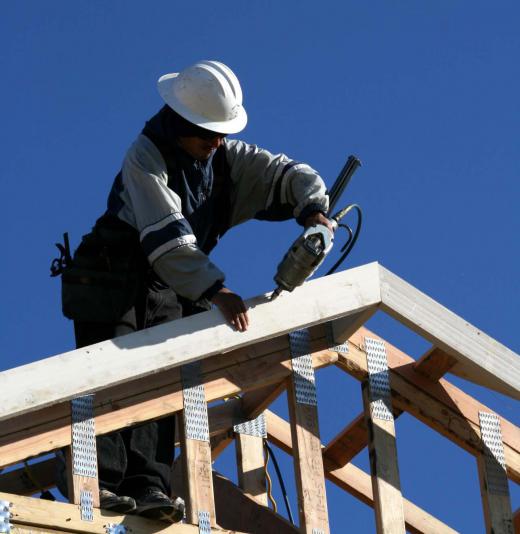A framing square, also known as a steel square or a carpenter's square, is a type of tool perhaps most commonly used by carpenters, general contractors, masonry contractors, and do-it-yourselfers to create clean angles and to accurately measure joints, joists, and planes. Despite its name, the tool is in most cases actually shaped like an L instead of a square, though it is used in many framing projects — from framing photos and artwork to actually providing framing structure for buildings. The tool’s main advantage is its ability to identify clean and even angles. It’s usually made of aluminum or other metal and has a long arm that forms a right angle with a shorter arm. The longer arm is typically used to measure right angles, as well as provide on its surface tables and scales commonly used by carpenters in a wide range of projects. Anyone involved in a building project or a project that requires ready access to tables and scales will find a framing square tremendously helpful in many aspects of calculating angles, cuts, and pitches.
Basic Appearance and Identifying Characteristics

The shape of the tool is often the best way to identify it. Most of the time, it looks like two rules or flat measuring rods fastened together to create a hinge. When folded, the tool is often quite portable, and looks a lot like a thick measuring stick. It usually unfurls to create a perfect 90° angle, which can be used to test and plot many different construction projects.

A standard framing or carpenter's square typically measures 24 inches (60.96 cm) long by 16 inches (40.64 cm) long. The narrower arm, called the tongue, is typically 1.5 inches (3.81 cm) wide. The wider arm is referred to as the blade and is usually 2 inches (5.08 cm) wide. There are variations, however, and longer, shorter, narrower, and wider tools are available in many places.
Primary Uses
The perfect angle provided by the tool allows craftspeople to create perfectly balanced corners and edges. There are of course a couple of ways to ensure evenness and accuracy in these areas, but the process can be challenging and often requires a number of careful calculations. Framing tools don’t take all of the work out of the process, but they do tend to make things easier, and make accurate results more likely in less time.
Testing angles is one of the simplest uses for the squares. When beams have been erected, rafters mounted, or artwork prepared for matting, for instance, a person can assess the fidelity of the angle by testing it against the square. The tool also has a host of uses in actual construction. It is commonly used to lay out and space rafters, stairs, and hip rafters, among other things.
Scales and Conversions
These tools also have an important role to play when it comes to measuring and scaling. Squares usually have three scales on them: diagonal, board foot, and octagonal. More modern iterations also have degree conversion charts for a variety of pitches and their fractional counterparts. There is also usually a table of numbers called the rafter table on the face of the square. This enables a carpenter to quickly calculate cutting angles and construction factors based on the Pythagorean theorem.
Early Models
Most scholars think that primitive tools matching the basic description of today's framing square were used by European craftsmen and builders centuries ago. It also received a patent in the United States in 1819. The man who patented it was a South Shaftsbury, Vermont, blacksmith named Silas Hawes. Rumor has it a peddler paid him for shoeing his horse by giving him some old saw blades, which he welded together to form the first carpenter's framing square in the country. He founded the Eagle Square Manufacturing Company in 1820 with associate Stephen Whipple and, for a time at least, was the authoritative and most respected provider of these tools anywhere in the U.S. Many more options are available today, and the tools are widely used throughout the world.
